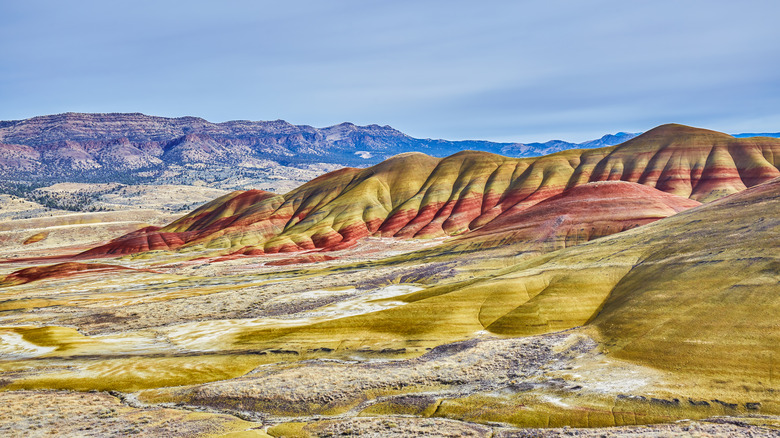One Of Oregon's Most Unique Natural Wonders Is An Off-The-Beaten-Path Colorful Hill Paradise
The Pacific Northwest is teeming with natural wonders. From a hidden waterfall on Oregon's coast to a rugged state park with breathtaking views, the region is a hotbed for outdoor adventures. However, one of the Northwest's most unique natural landmarks is Oregon's Painted Hills. Buried deep in the heart of the state, it's miles away from rainforests, coastlines, and the delicious coffee of Portland. Nonetheless, the trip is more than worth the effort, as few places in the country are as otherworldly as these rolling hills.
The Painted Hills are part of the John Day Fossil Beds National Monument near the little town of Mitchell. The park is comprised of three distinct units, though Painted Hills is undoubtedly the most popular. So, even though you're truly out in the wilderness, there's a good chance you'll encounter a few other travelers during your trip. You'll likely be able to explore everything the landscape has to offer in an afternoon (only a few miles of trails exist in this unit), but you'll find countless other natural wonders in the area that would make it easy to fill up your entire weekend.
Wander the Painted Hills of Oregon
Oregon's Painted Hills formed about 35 million years ago, and its vibrant colors correspond to different climates over the years. The expansive swaths of red soil dancing across the hills were created during times with tropical climates, while the yellows come from times with temperate climates. You can easily see these patterns by hiking to the Painted Hills Overlook. The short path is less than a mile long and offers sweeping views of the entire region.
Painted Hills Overlook is one of five trails in the park. Most trails are incredibly short, with only the Carroll Rim Trail running for over a mile. This unshaded hike climbs nearly 400 feet, ending atop a small rise and granting even more panoramic views of the Painted Hills. It's recommended that you explore all five trails, as they're conveniently located off Bear Creek Road. If you're traveling in an RV or large vehicle, however, the roads aren't conducive to driving beyond the Painted Hills Overlook.
Keep in mind that visitors are asked to remain on trails and pathways at all times — venturing off the trail is prohibited. And while the Pacific Northwest might be known for its rainy weather and shaded forests, the deserts around Painted Hills aren't your typical Pacific Northwest. Because of this, be sure to pack additional water and wear protective layers if visiting in the summer.
Visit the rest of John Day Fossil Beds
There's no doubt the Painted Hills are a memorable sight, but once you've wandered its few trails, there's not much else to do. However, you should strongly consider using any extra time in your schedule to visit the remaining units of the John Day Fossil Beds. These units are spread out a few hours from each other, but each provides visitors with remarkable terrain that's hard to find elsewhere in the Pacific Northwest.
The Clarno unit is around two hours north of Painted Hills, but you'll get to view fossils from an ancient semi-tropical rainforest. This unit has even fewer trails than Painted Hills — but you'll want to slowly meander these paths as you scour the surroundings for fossils. The Trail of Fossils is particularly notable, as it'll take you to leaf imprints and pieces of wood lodged into fallen rocks.
The Sheep Rock unit is better suited for hiking, with over five miles of trails. It's an hour east of Painted Hills, and aside from more hiking, it's also home to the Thomas Condon Visitor Center. This impressive building runs a 20-minute orientation video highlighting the best of the park and offers exhibits displaying over 500 local fossils. If you need a break from the sun (or all the driving), be sure to stop by.


